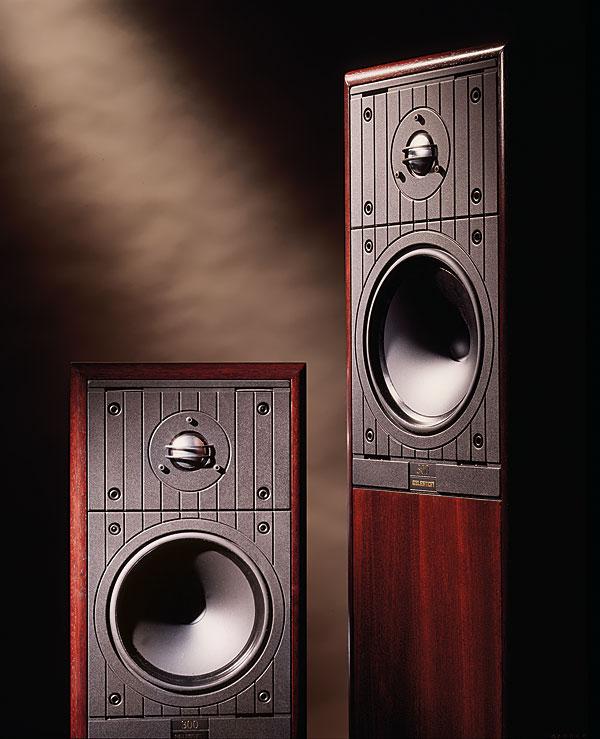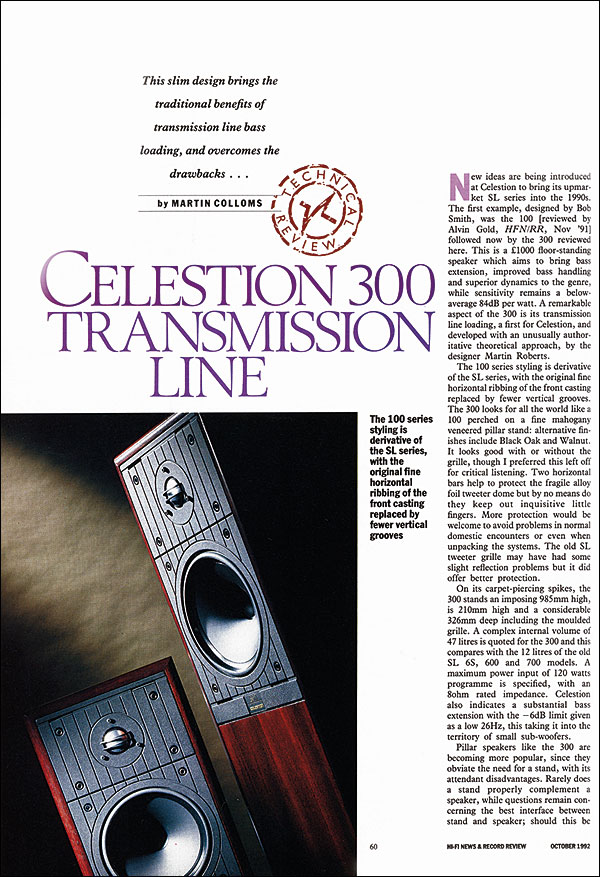Celestion 300 floorstander

 This slim design offers the traditional benefits of transmission line bass loading yet manages to overcome the drawbacks, says Martin Colloms
This slim design offers the traditional benefits of transmission line bass loading yet manages to overcome the drawbacks, says Martin Colloms
New ideas are being introduced at Celestion to bring its upmarket SL series into the 1990s. The first example, designed by Bob Smith, was the 100 [HFN Nov '91] followed now by the 300 reviewed here. This is a £1000 floorstander that aims to bring improved bass extension, power handling and superior dynamics to the genre, while sensitivity remains below average at 84dB/1W. A remarkable aspect of the 300 is its transmission line loading, a first for Celestion, and developed with an unusually authoritative theoretical approach, by the designer Martin Roberts.
Tall Story
The 100 series styling is derivative of the SL series, with the original fine horizontal ribbing of the front casting replaced by fewer vertical grooves. The 300 looks for all the world like a 100 perched on a fine mahogany veneered pillar-stand (alternative finishes include Black Oak and Walnut). It looks good with or without the grille, though I preferred this left off for critical listening. Two horizontal bars help to protect the fragile alloy foil tweeter dome but by no means do they keep out inquisitive little fingers. More protection would be welcome in normal domestic environments.

On its carpet-piercing spikes, the 300 stands an imposing 985mm tall, is 210mm wide and a considerable 326mm deep including the moulded grille. A complex internal volume of 47 litres is quoted for the 300 and this compares with the 12 litres of the old SL6S, 600 and 700 models. A maximum power input of 120W programme is specified, with an 8ohm rated impedance. Celestion also indicates a substantial bass extension with the –6dB limit given as a low 26Hz, this taking it into the territory of small subwoofers.
On Point?
Pillar speakers such as the 300 are becoming more popular, since they obviate the need for a stand, with its attendant disadvantages. Rarely does a stand properly complement a speaker, while questions remain concerning the best interface between stand and speaker; should this be points, cones, mastic or felt? The stand represents a variable which the pillar speaker avoids. Meanwhile, electrical connection is by means of gold-plated binding posts that can be bi-wired. There are no fuses or other protection devices.
The Technology
Fundamental to the Celestion 300 is the development of a transmission line which steers a course between ineffectiveness due to overdamping and over-activity due to secondary resonances that are underdamped. A perfect transmission line is a structure that receives energy without reflection, conducting it down a defined path which will inevitably include some loss.
For acoustic purposes, when back-loading a bass driver, a transmission line should be long compared with the lowest frequency of interest, say 20Hz. If of high absorption, the line may effectively terminate all the energy entering it, with the result that the far end of the line may be open or closed with little effect on the overall result.

In practice, finite-sized speakers require lines of finite dimensions, rather less than the 17m wavelength of 20Hz. In fact the line section in the Celestion 300 is 1.7m, which places the quarter-wave pipemode resonance, the one which is in phase with and reinforces the frontal output of the driver, at 50Hz approximately. In theory, at frequencies lower than 50Hz the line output falls progressively out of phase and by 35Hz little output will be available. In practice, loading and line damping increases the effective mass in the pipe or line, the result being a lowering of the cut-off frequency to 30Hz.
Life for the system designer would be relatively simple if the behaviour of the line was confined to just the 1⁄4 wave mode. Unfortunately for the loudspeaker (though fortunately for musical instruments based on pipes or tubes), additional higher-order resonant modes are present. These are placed approximately at the odd-order values, 3⁄4, 5⁄4 and 7⁄4, in addition to the prime 1⁄4 wave resonance. These extra modes add welcome colour and character to an instrument, but from the viewpoint of the loudspeaker driving the line, this complex behaviour can be seen as a non-uniform acoustic termination offered by the entry to the line. The series of upper resonances will also include reactive components, that is, the acoustic equivalents of electrical inductance and capacitance.
Martin Roberts had researched an initial paper on transmission lines published in 1990 which explored various fillings and timings. Later work has concerned alternative techniques for terminating the higher modes. Normally the pipe is filled with an absorptive material. This must not be allowed to move since such random motion is equivalent to lossy hysteresis and can affect the transient performance in the bass in a nonlinear manner. Roberts' work indicates that line tapering has little effect on the upper modes while sufficient absorbency for their control also generally results in excessive loss at the 'fundamental' 1⁄4 wave mode.
Critical Load
Roberts' work, which exploits the approach taken by G Letts, concerns the use of a low-pass acoustic filter ahead of the pipe and loaded by it, which terminates the driver at higher frequencies. In the electrical analogy, this is an LC filter which, in the case of the 300 system, is formed by a stiffness component represented by an 'expansion' chamber behind the driver leading to a pipe entrance that is significantly smaller.
For Celestion, the specific proximity of the pipe entrance to the back of the driver is exploited, giving a clear differentiation in the lumped analysis for the system, and this distinguishes it from the chamber entrance to a tapered line which is more commonly employed.
























































